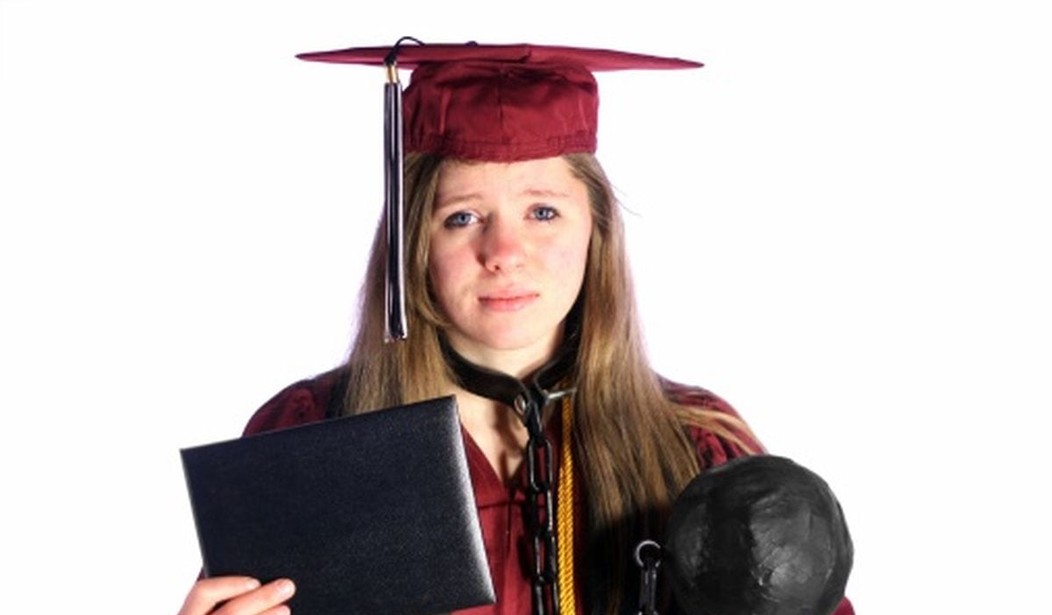What is the moral hazard in forgiving student loan debt?
That question will become very relevant in the next few years as student loan costs to borrowers and lenders alike skyrocket out of control.
Thanks to extremely generous government loan programs, the amount of loans to college students has ballooned to where it is now the second-highest consumer debt burden, surpassing auto and credit card debt and trailing only mortgage debt.
Some recent statistics (4Q 2016) from the New York Federal Reserve:
Total Student Loan Debt: $1.31 trillion
Total U.S. Borrowers With Student Loan Debt: 44.2 million
Student Loan Delinquency Or Default Rate: 11.2%
Total Increase In Student Loan Debt In 4Q2016: $31 billion
New Delinquent Balances (30+ days): $32.6 billion
New Delinquent Balances – Seriously Delinquent (90+ days): $31 billion
So the question of how much or even whether we should be forgiving student loans will have a huge impact on society — and especially the economy — in the coming decade.
Young people with enormous amounts of student debt are hamstrung in obtaining credit for housing, autos, and household goods. This proves to be a drain on the economy. There is evidence that carrying that debt forces young people to put off marriage and children. It is changing the lifestyle of the current generation and not for the better.
So the government has developed some programs to forgive all or part of that debt. One of these programs — Public Service Loan Forgiveness (PSLF) — was based on the simple notion that if a graduate decided to pursue a career in government service, a portion of his student debt should be forgiven.
But as this Politico article points out, the law of unintended consequences has been applied and program costs are set to double to $24 billion over the next 10 years.
Early warnings that PSLF could grow out of control were easily dismissed as speculation. Even after it was enacted, the government declined to collect or publish information on it. There were no enrollment figures, no statistics on the debt level of participants, and most importantly, no smoking-gun number in the federal budget showing how much debt the government would have to write off.
That has started to change. The latest CBO estimate, which came as part of the budget agency’s analysis of President Donald Trump’s proposal to end PSLF for new borrowers, is part of the growing evidence that the program will forgive far more debt for far more people than anyone originally thought. The Department of Education now publishes enrollment figures that show nearly 60,000 new borrowers enroll in PSLF every quarter. Other Department statistics show that most participants borrowed well in excess of $50,000 in federal loans and one-third borrowed more than $100,000. Such high debt levels indicate that the program is mostly benefiting borrowers with graduate degrees.
If those statistics aren’t convincing evidence of a problem, the “repayment estimator” available on the Department’s website should be. Enter in a borrower with $50,000 in debt earning an adjusted gross income of $40,000 and the site calculates the amount of debt the student would have forgiven. (Note that adjusted gross income excludes an individual’s pre-tax contributions to things like health insurance premiums, retirement savings, and even student loan interest payments.) Payments over 10 years total $30,168, nowhere near enough to pay the debt, which means she has $49,832 in principal and accrued interest forgiven. Enter in $100,000 in debt, and the borrower still makes payments of $30,168, but the amount forgiven is a whopping $129,832.
Let that sink in for a moment. Payments are the same if the student borrows $50,000 or $100,000. Taxpayers foot the bill for the difference. One has to wonder whether PSLF would have been enacted if the department launched its repayment estimator before the lawmakers voted to create it.
The proposed 2018 budget eliminates this program for new borrowers, but it seems too little, too late. The PSLF will grow regardless of what limits are placed on it for several years.
In the end, you’re only talking about forgiving $24 billion out of $1.3 trillion – the proverbial drop in the bucket. Democrats have proposed sweeping student debt forgiveness legislation, but as long as the GOP controls Congress and the White House, the bill isn’t going anywhere.
What’s needed is a re-examination of the benefits of a college education. Community colleges are far less expensive than four-year schools, and could give a sizable number of high school graduates a good start toward a career. For-profit technical schools are also an option, although the federal government declared war on them during the Obama years.
The point being, while loans will still be necessary, they should be smaller with more generous terms so they are easier to pay back. Government subsidizing a low interest rate is far less expensive than relieving debt.
This doesn’t solve the question of what to do about the 44 million holders of student debt today. It may be that Congress will have to bite the bullet and forgive a certain percentage of that $1.3 trillion — a consequence of profligate policies in the past. Along with that debt forgiveness must come serious reform of student loan programs that take the question of paying back the loan more seriously than today.










Join the conversation as a VIP Member